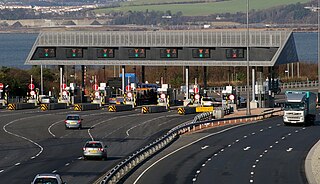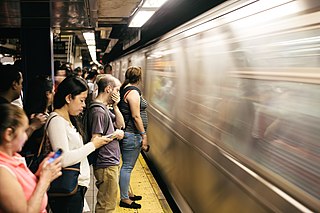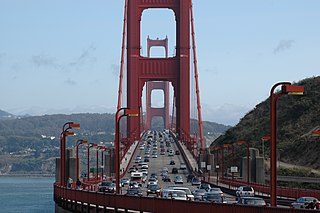Related Research Articles

A high-occupancy vehicle lane is a restricted traffic lane reserved for the exclusive use of vehicles with a driver and at least one passenger, including carpools, vanpools, and transit buses. These restrictions may be only imposed during peak travel times or may apply at all times. There are different types of lanes: temporary or permanent lanes with concrete barriers, two-directional or reversible lanes, and exclusive, concurrent, or contraflow lanes working in peak periods. The normal minimum occupancy level is two or three occupants. Many jurisdictions exempt other vehicles, including motorcycles, charter buses, emergency and law enforcement vehicles, low-emission and other green vehicles, and/or single-occupancy vehicles paying a toll. HOV lanes are normally introduced to increase average vehicle occupancy and persons traveling with the goal of reducing traffic congestion and air pollution.

A ramp meter, ramp signal, or metering light is a device, usually a basic traffic light or a two-section signal light together with a signal controller, that regulates the flow of traffic entering freeways according to current traffic conditions. Ramp meters are used at freeway on-ramps to manage the rate of automobiles entering the freeway. Ramp metering systems have proved to be successful in decreasing traffic congestion and improving driver safety.

A parking meter is a device used to collect money in exchange for the right to park a vehicle in a particular place for a limited amount of time. Parking meters can be used by municipalities as a tool for enforcing their integrated on-street parking policy, usually related to their traffic and mobility management policies, but are also used for revenue.

Road pricing are direct charges levied for the use of roads, including road tolls, distance or time-based fees, congestion charges and charges designed to discourage the use of certain classes of vehicle, fuel sources or more polluting vehicles. These charges may be used primarily for revenue generation, usually for road infrastructure financing, or as a transportation demand management tool to reduce peak hour travel and the associated traffic congestion or other social and environmental negative externalities associated with road travel such as air pollution, greenhouse gas emissions, visual intrusion, noise pollution and road traffic collisions.

Congestion pricing or congestion charges is a system of surcharging users of public goods that are subject to congestion through excess demand, such as through higher peak charges for use of bus services, electricity, metros, railways, telephones, and road pricing to reduce traffic congestion; airlines and shipping companies may be charged higher fees for slots at airports and through canals at busy times. Advocates claim this pricing strategy regulates demand, making it possible to manage congestion without increasing supply.

Traffic congestion is a condition in transport that is characterized by slower speeds, longer trip times, and increased vehicular queueing. Traffic congestion on urban road networks has increased substantially since the 1950s. When traffic demand is great enough that the interaction between vehicles slows the traffic stream, this results in congestion. While congestion is a possibility for any mode of transportation, this article will focus on automobile congestion on public roads.

Parking is the act of stopping and disengaging a vehicle and leaving it unoccupied. Parking on one or both sides of a road is often permitted, though sometimes with restrictions. Some buildings have parking facilities for use of the buildings' users. Countries and local governments have rules for design and use of parking spaces.

Electronic toll collection (ETC) is a wireless system to automatically collect the usage fee or toll charged to vehicles using toll roads, HOV lanes, toll bridges, and toll tunnels. It is a faster alternative which is replacing toll booths, where vehicles must stop and the driver manually pays the toll with cash or a card. In most systems, vehicles using the system are equipped with an automated radio transponder device. When the vehicle passes a roadside toll reader device, a radio signal from the reader triggers the transponder, which transmits back an identifying number which registers the vehicle's use of the road, and an electronic payment system charges the user the toll.

A rush hour or peak hour is a part of the day during which traffic congestion on roads and crowding on public transport is at its highest. Normally, this happens twice every weekday: once in the morning and once in the afternoon or evening, the times during which most people commute. The term is often used for a period of peak congestion that may last for more than one hour.

The San Francisco Municipal Transportation Agency is an agency created by consolidation of the San Francisco Municipal Railway (Muni), the Department of Parking and Traffic (DPT), and the Taxicab Commission. The agency oversees public transport, taxis, bicycle infrastructure, pedestrian infrastructure, and paratransit for the City and County of San Francisco.

Slugging, also known as casual carpooling, is the practice of forming ad hoc, informal carpools for purposes of commuting, essentially a variation of ride-share commuting and hitchhiking. A driver picks up these non-paying passengers at key locations, as having these additional passengers means that the driver can qualify to use an HOV lane or enjoy toll reduction. While the practice is most common and most publicized in the congested Washington, D.C. metropolitan area, slugging also occurs in San Francisco, Houston, and other cities.

Transportation demand management or travel demand management (TDM) is the application of strategies and policies to increase the efficiency of transportation systems, that reduce travel demand, or to redistribute this demand in space or in time.

San Francisco congestion pricing is a proposed traffic congestion user fee for vehicles traveling into the most congested areas of the city of San Francisco at certain periods of peak demand. The charge would be combined with other traffic reduction projects. The proposed congestion pricing charge is part of a mobility and pricing study being carried out by the San Francisco County Transportation Authority (SFCTA) to reduce congestion at and near central locations and to reduce its associated environmental impacts, including cutting greenhouse gas emissions. The funds raised through the charge will be used for public transit improvement projects, and for pedestrian and bike infrastructure and enhancements.

Donald Curran Shoup is an American engineer and professor in urban planning. He is a research professor of urban planning at University of California, Los Angeles and a noted Georgist economist. His 2005 book The High Cost of Free Parking identifies the negative repercussions of off-street parking requirements and relies heavily on 'Georgist' insights about optimal land use and rent distribution. In 2015, the American Planning Association awarded Shoup the "National Planning Excellence Award for a Planning Pioneer."

A high-occupancy toll lane is a type of traffic lane or roadway that is available to high-occupancy vehicles and other exempt vehicles without charge; other vehicles are required to pay a variable fee that is adjusted in response to demand. Unlike toll roads, drivers have an option to use general purpose lanes, on which a fee is not charged. Express toll lanes, which are less common, operate along similar lines, but do not exempt high-occupancy vehicles.
The Urban Partnership Agreement (UPA) is an effort of the United States Department of Transportation and agencies in four metropolitan areas across the country which are testing out several technologies as an effort to reduce congestion in urban areas. The metro areas of Miami, Florida, Minneapolis, Minnesota, San Francisco, California, and Seattle, Washington are participants. The technologies being used include bus rapid transit (BRT), high-occupancy toll lane (HOT) lanes and other congestion pricing, dynamic message signs, and other lane management signage.
Pay-by-plate machines are a subset of ticket machines used for regulating parking in urban areas or in parking lots. They enable customers to purchase parking time by using their license plate number. The machines print a receipt that generally displays the location, machine number, start time, expiration time, amount paid, and license plate.
Urban freight distribution is the system and process by which goods are collected, transported, and distributed within urban environments. The urban freight system can include seaports, airports, manufacturing facilities, and warehouse/distribution centers that are connected by a network of railroads, rail yards, pipelines, highways, and roadways that enable goods to get to their destinations.

The Sustainable Transport Award (STA), is presented annually to a city that has shown leadership and vision in the field of sustainable transportation and urban livability in the preceding year. Nominations are accepted from anyone, and winners and honorable mentions are chosen by the Sustainable Transport Award Steering Committee.

A managed lane is a type of highway lane that is operated with a management scheme, such as lane use restrictions or variable tolling, to optimize traffic flow, vehicle throughput, or both. Definitions and goals vary among transport agencies, but managed lanes are generally implemented to achieve an improved operational condition on a highway, such as improving traffic speed and throughput, reducing air pollution, and improving safety. Types of managed lanes include high-occupancy vehicle (HOV) lanes, high-occupancy toll lanes, express toll lanes, reversible lanes, and bus lanes. Most managed lane facilities are located in the United States and Canada, although HOV and bus lanes can be found in many other countries; outside of the US and Canada, many countries use active traffic management that manage all lanes of a highway.
References
- 1 2 Gordon, Rachel (July 27, 2010). "High-tech parking meters premiere in S.F." SFGATE. Retrieved November 16, 2023.
- ↑ "Press Release: FHWA Deputy Administrator Helps Launch SFpark in San Francisco, 4/21/2011 | Press Releases | Federal Highway Administration". www.fhwa.dot.gov. Retrieved November 16, 2023.
- ↑ San Francisco congestion pricing
- 1 2 3 Matt Richtel. NY Times. Now, to Find a Parking Spot, Drivers Look on Their Phones. May 7, 2011.
- ↑ Pricing – SFpark
- ↑ Data – Resource Types – SFpark
- ↑ "SF Launches Another Parking App That Appears To Require Cell Phone Use (Or A Navigator) While Driving | SF Appeal: San Francisco's Online Newspaper" . Retrieved November 16, 2023.
- ↑ SFpark hourly meters actually saves motorists money | Transportation | San Francisco | San Francisco Examiner
- ↑ Millard-Ball; Weinberger; Hampshire (March 2014). "Is the Curb 80% Full or 20% Empty? Assessing the Impacts of San Francisco's Parking Pricing Experiment" (PDF). Retrieved April 7, 2014.
- ↑ Shriver, Adam. "Understanding the Block-Level Price Elasticity of On-Street Parking Demand: A Case Study of San Francisco's SFpark Project". ResearchGate. Retrieved October 13, 2016.
- ↑ Chinn, Jerold (December 6, 2018). "Demand-based parking to stretch citywide in 2018". SF Bay. Retrieved July 11, 2018.